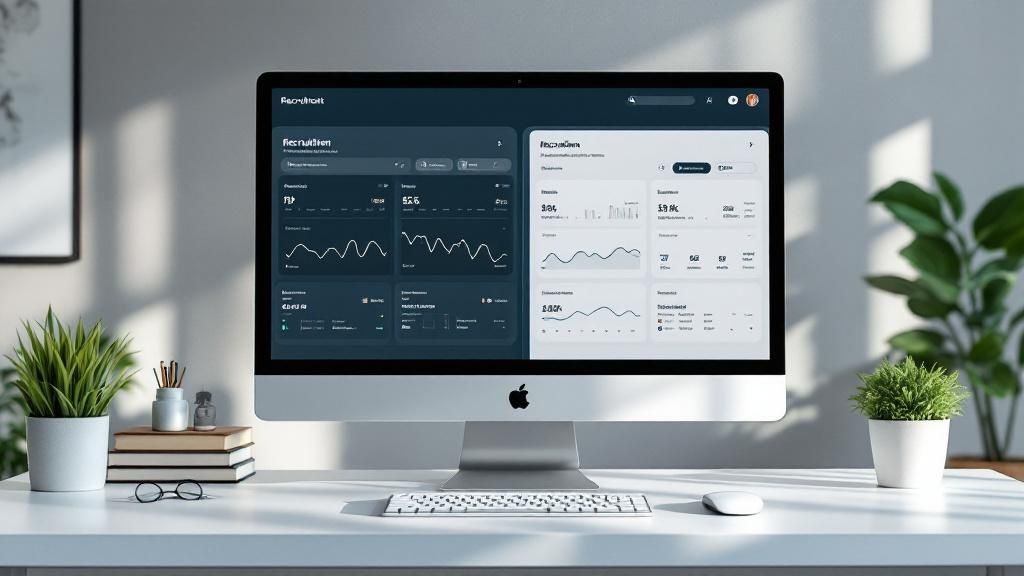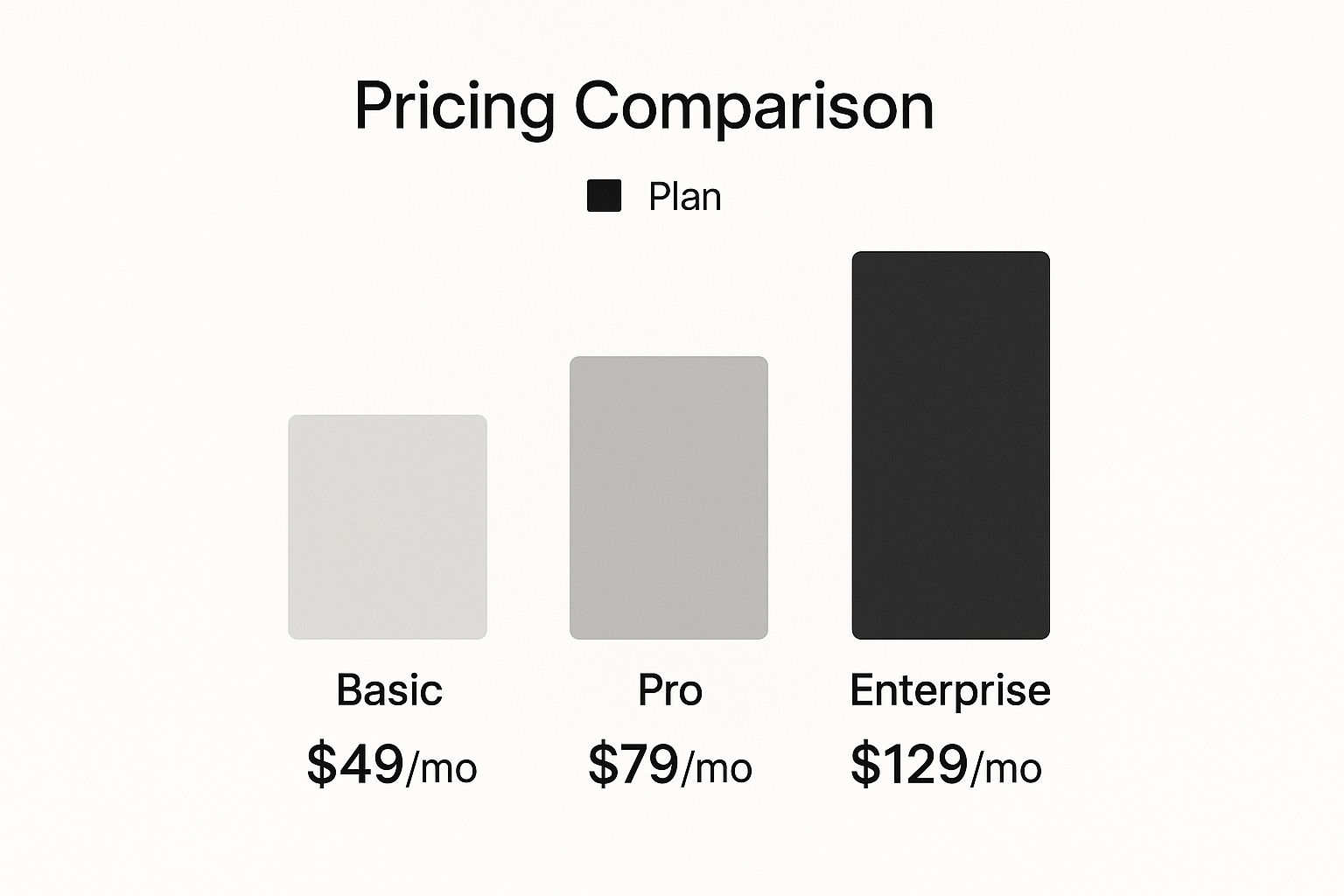August 16, 2025
Recruitment Software Comparison Finding Your Best Fit

After a deep dive into recruitment software comparison, one thing becomes crystal clear: the "best" tool is entirely relative. It all comes down to your business size, how many people you're hiring, and what you’re trying to achieve. A startup might just need a clean, easy-to-use Applicant Tracking System (ATS), while a massive enterprise will be hunting for a full talent acquisition suite packed with advanced analytics and CRM features to handle their complex hiring machine.
Decoding Your Recruitment Software Needs
Let's be honest, navigating the modern hiring world can feel overwhelming. That’s why the right software isn't just an expense; it’s a critical investment. Choosing well can transform your hiring process from a purely administrative, reactive chore into a strategic, data-backed advantage.
A great platform streamlines everything, creates a better experience for candidates, and ultimately helps you land top talent before your competitors even get a chance. This guide is designed to cut through the marketing noise and give you a straightforward recruitment software comparison to find your perfect match.
Core Distinctions: Applicant Tracking vs. Full Suites
First things first, you need to understand the fundamental difference between the main types of software out there. An Applicant Tracking System (ATS) is your foundational tool. Think of it as a digital filing cabinet designed to manage and organize the applications that come flooding in.
On the other hand, a full talent acquisition suite is a much more powerful solution. It includes an ATS, but it also bolts on a whole range of proactive features for sourcing, engagement, and long-term relationship building.
Here’s a simple way to look at their core functions:
This screenshot gives you a good look at a typical ATS workflow, showing how candidates are tracked and moved through the different stages of the hiring process.

You can see the linear path from application to hire, which is exactly what an ATS is built to do well.
This shift toward more sophisticated tools is backed by hard numbers. The global recruitment software market was valued at US$ 3.30 billion in 2025 and is on track to nearly double, hitting US$ 6.20 billion by 2032, all driven by the relentless need to automate hiring.
Picking the right software is a cornerstone of modern talent acquisition strategies and is absolutely essential for staying competitive.
Establishing Your Evaluation Criteria
Jumping into a recruitment software comparison without a clear plan is a classic mistake. It's like walking onto a car lot with no idea if you need a minivan or a two-seater. To choose wisely, you first need to build your own evaluation framework—a scorecard that reflects your team's real-world hiring challenges and goals.
This isn't about creating a massive checklist of every possible feature. Instead, let's focus on what truly moves the needle. A great platform does more than just organize applicants; it should actively help you find, engage, and understand talent in a smarter way.
Core Functional Requirements
First things first, let's cover the non-negotiables. These are the foundational capabilities that handle the daily grind of hiring and have a direct impact on your team's sanity and efficiency. Get these right, and everything else falls into place.
Think about these essential areas:
- Applicant Tracking and Pipeline Management: How easy is it to actually move candidates from one stage to the next? Can you set up custom workflows for different roles, like a software engineer versus a sales lead? The system needs to give you a clean, visual snapshot of your entire hiring pipeline at a glance.
- Sourcing and Candidate CRM: Does the software just manage active applicants, or does it help you build a bench of talent for the future? Look for tools that let you source passive candidates from different places and nurture those relationships over time.
- Interview Scheduling and Coordination: Let's be honest, scheduling is a time-sucking vortex. A solid system takes this off your plate by syncing with calendars, letting candidates pick their own time slots, and wrangling multiple interviewers without endless email chains.
A study I came across noted that the best applicant tracking systems improved the hiring process for 94% of recruiters. This really drives home how much of a difference it makes when these core, foundational features are done well.
Strategic and Technical Considerations
Once you've nailed down the day-to-day functional needs, it's time to zoom out. This is where you look at the strategic and technical side of things—how this new tool will plug into your existing world and grow with you. A platform can have all the bells and whistles, but if it doesn’t play nice with your other systems, it’s going to cause major headaches.
This part is all about long-term fit and future-proofing your decision.
- Integrations with Your HR Tech Stack: Your recruitment software can't live on an island. It absolutely must talk to your Human Resources Information System (HRIS), payroll, and onboarding tools. If it doesn't, you're signing up for manual data entry and frustrating information gaps.
- Analytics and Reporting: Can you easily see what's working and what isn't? You need to be able to track crucial metrics like time-to-hire, cost-per-hire, and which sources are actually delivering quality candidates. The goal is actionable insights from customizable dashboards, not just a spreadsheet full of numbers.
- Security and Compliance: Protecting candidate data isn't optional; it's a massive responsibility. Make sure any platform you consider is compliant with regulations like GDPR or CCPA and has serious security measures in place to protect sensitive information.
To help you put this into practice, here's a checklist you can adapt to build your own evaluation scorecard. It’s designed to force the right questions and help you prioritize what matters most to your organization.
Recruitment Software Evaluation Checklist
This checklist is your starting point. Adjust the "Importance" column based on your specific pain points and strategic objectives. A well-defined set of criteria is the best tool you have for cutting through the marketing noise and finding a platform that will be a true asset to your team, not just for today but for years to come.
A Head-to-Head Look at the Top Platforms
Now that we have a solid evaluation framework, let's dive into a real-world recruitment software comparison of the industry’s heavy hitters. This isn't just about listing features; it's about understanding the core philosophies behind three leading platforms: Greenhouse, Lever, and Workday Recruiting. Each one shines in different scenarios and is built for very different hiring cultures.
The point here isn’t to pick one "best" platform. Instead, my goal is to highlight the subtle but critical differences that actually matter day-to-day. We'll get into how each one tackles major recruiting hurdles, from keeping teams aligned to making sense of hiring data, so you can see which solution truly fits your team’s workflow.
Greenhouse: The Champion of Structured Hiring
Greenhouse has built its reputation on a disciplined, highly structured approach to recruiting. The entire system is designed around the concept of structured hiring—a method that aims to strip bias out of the process and drive consistency by making sure every single candidate is measured against the exact same yardstick.
This makes Greenhouse the go-to choice for companies that put process, fairness, and clean data above everything else. Its workflow is intentionally rigid, forcing teams to follow a consistent, repeatable plan for every role. For instance, creating a job requisition isn’t just about posting a description; it involves building a detailed "scorecard" with specific skills and interview questions that everyone must use.
This methodical nature ensures all feedback is standardized, which makes comparing candidates far more objective. If you're scaling fast and can't afford to let hiring quality slip across different departments, Greenhouse provides the guardrails to keep everyone on track.
Greenhouse operates on a simple but powerful belief: a better hiring process leads to better hires. Its rigid structure isn’t a bug, it’s a feature. It’s designed to enforce the kind of discipline that top-tier, data-driven talent teams need to make hiring decisions they can stand behind.
This focus on structure carries over to its analytics, which are incredibly powerful. The platform gives you a deep view into every single stage of your hiring funnel. You can pinpoint bottlenecks, keep an eye on diversity metrics, and even measure how effective specific interviewers or sourcing channels are.
Lever: The Collaborative Relationship Builder
Where Greenhouse zigs with structure, Lever zags with a more fluid, relationship-focused approach. It’s not just an Applicant Tracking System (ATS); it's a powerful Candidate Relationship Management (CRM) system baked right in. People often call it a "CRM-first" ATS, and that design choice says it all: it's built for nurturing talent over the long haul, not just processing active applicants.
Lever's interface feels fast and collaborative. It pulls everything—resumes, emails, social media profiles, and internal comments—into one unified candidate profile. This simple but brilliant feature makes it so much easier for recruiters and hiring managers to see the full story of a candidate's interactions with your company without jumping between different tools.
One of its biggest differentiators is the seamless way it works with email and calendars, which makes outreach feel personal, not robotic. Recruiters can basically live in their inbox, and Lever automatically syncs every conversation back to the candidate’s profile. This is a game-changer for teams obsessed with providing a high-touch, white-glove candidate experience.
- Unified Profiles: Every touchpoint, from the first cold email to the final offer letter, lives in a single, continuous timeline.
- Nurture Campaigns: Recruiters can easily build and send email campaigns to keep pools of passive candidates engaged for future openings.
- Intuitive Collaboration: Tagging a colleague or leaving feedback is as simple as an @-mention, which keeps conversations flowing right inside the platform.
For companies fighting for talent in hyper-competitive markets, building those long-term relationships is everything. Lever gives teams the tools they need to be more strategic and proactive instead of just reactive.
Workday Recruiting: The All-in-One HR Powerhouse
Workday Recruiting is a different animal altogether. It isn't a standalone tool you can buy off the shelf; it's a core piece of the massive Workday Human Capital Management (HCM) suite. Its biggest selling point is its flawless integration with every other part of HR—payroll, benefits, performance reviews, you name it.
For big companies already running on Workday for their core HR functions, adding the recruiting module is almost a no-brainer. This creates a true single source of truth for all employee data, from the moment someone applies to the day they retire. When a candidate accepts an offer, their information flows automatically into the onboarding and payroll systems. No more manual data entry, no more errors.
This unified ecosystem offers a level of visibility that standalone tools just can't match. A hiring manager can see a candidate’s application history right alongside data on internal mobility and succession plans for their existing team, leading to much smarter workforce planning.
But that tight integration is also its biggest weakness for companies not already bought into the Workday world. As a pure recruiting tool, it can feel clunky and less nimble than best-of-breed options like Greenhouse or Lever. The user interface, while powerful, often feels like it was designed more for an HR generalist than for a fast-moving recruiter.
This platform is built for massive organizations that require ironclad compliance, security, and global capabilities to be hardwired into their HR processes. Increasingly, large companies depend on this kind of integration to handle candidate filtering and data management automatically. AI-powered features in these systems can automate everything from job postings to candidate tracking, ensuring applicant data is handled quickly and confidentially.
Comparing Key Functional Areas
Let's break down how these platforms really differ in a few critical areas.
| Feature Area | Greenhouse | Lever | Workday Recruiting |
| :--- | :--- | :--- |
| Hiring Process | Highly Structured: Enforces consistent, scorecard-based evaluations to reduce bias. | Flexible & Collaborative: Prioritizes speed, communication, and relationship-building. | Integrated & Process-Driven: Aligns recruitment with broader HCM workflows and internal mobility. |
| Candidate Sourcing | Strong sourcing tools but secondary to pipeline management. | CRM-First: Excellent for nurturing passive talent pools and proactive outreach. | Good internal sourcing capabilities, leveraging existing employee data. |
| User Experience | Clean and process-oriented, guides users through defined steps. | Intuitive and communication-focused, feels like a modern email client. | Can be complex; designed for HR generalists as much as recruiters. |
| Analytics | Deep, customizable reporting on pipeline health and process efficiency. | Strong analytics with a focus on sourcing effectiveness and nurture campaigns. | Powerful, enterprise-grade analytics connected to all HCM data. |
| Best For | Scaling companies prioritizing consistency, data, and fair hiring. | Teams focused on high-touch candidate experience and proactive sourcing. | Large enterprises already using the Workday HCM suite seeking a unified system. |
This table makes it clear: there's no single best option. A recruitment software comparison has to be about your specific context. A startup would likely feel suffocated by Greenhouse's rigid structure, while a highly regulated global corporation might find Lever’s flexibility to be a compliance nightmare.
One of the most important automated features in any of these systems is resume screening. The ability to quickly process and rank candidates at the top of the funnel saves an incredible amount of time. For a deeper dive into this technology, check out our guide on automated resume screening software.
Pricing and Scalability Considerations
The pricing models for these platforms also tell a story about who they're built for. This chart gives you a general idea of how pricing is often structured in the market, based on features and company needs.

This visual shows a pretty standard tiered model where the more you pay, the more functionality you unlock, which is common across the recruiting software landscape.
Greenhouse and Lever generally price their software on a per-employee basis or in tiers that grow with your company, which keeps them within reach for startups and scale-ups. Workday is a true enterprise-level investment, and its price tag reflects its role as a complete HCM platform. When you're budgeting, make sure to think about the total cost of ownership—that includes implementation, training, and any third-party integration fees.
Ultimately, picking the right platform means taking a hard look at your own company's culture, priorities, and growth plans. To see what else is out there, it’s worth exploring a list of top job recruitment agents and platforms to get the full picture. When you align a platform's core philosophy with your own, you end up with a strategic asset, not just another piece of software.
Matching Software to Your Business Needs

Any solid recruitment software comparison has to start with your own business reality. What works for a fast-moving tech startup is going to be completely wrong for a global corporation that needs iron-clad compliance and deep analytics. This is where the feature list on a website meets the real world of your daily hiring grind.
Connecting a platform’s promises to your actual hiring challenges is the final, and most important, piece of the puzzle. A tool that seems perfect in a demo can quickly become a bottleneck if it doesn't mesh with how your team gets things done. Let's walk through a few common scenarios to see how different software aligns with specific needs.
High-Growth Startups and Scale-Ups
When you're a startup or a company in a major growth spurt, everything is about speed, agility, and the candidate experience. You're trying to move fast, snag top talent before your competitors do, and build a great culture from the ground up. In this kind of environment, a collaborative, CRM-first platform is almost always the right call.
You need a system that feels natural and doesn't force your team into rigid, clunky processes. The name of the game is proactive sourcing and building talent pools for roles that might not even be on the roadmap yet.
- Priority Needs: Quick time-to-hire, easy collaboration tools for hiring managers, and powerful candidate relationship management (CRM) features.
- Best Fit: A platform like Lever often shines here because it’s built around communication and a more fluid, relationship-focused workflow.
Global Enterprises and Regulated Industries
Big companies play by a different set of rules. For them, consistency, compliance, and data security are non-negotiable. Hiring processes have to be standardized across dozens of departments and countries, and the software absolutely must plug into a complex ecosystem of other Human Capital Management (HCM) tools.
In this case, a unified, all-in-one system is usually the only practical choice. Being able to link recruitment data with things like internal mobility, succession planning, and performance management gives you a complete picture of your entire talent lifecycle.
For a large, established company, recruitment isn’t just about filling open positions. It’s a core piece of long-term workforce planning. The software has to support that strategic, big-picture vision.
The global context matters, too. The recruitment software market hit USD 2.38 billion in 2024, and North America accounts for a massive 35.3% share, largely because companies here were early to adopt cloud-based platforms. These systems are essential for the real-time collaboration needed to manage a global workforce. You can dig into more of this data in the IMARC Group’s market analysis.
Businesses with High-Volume Hiring Needs
Think about companies in retail, hospitality, or logistics that need to hire huge numbers of hourly or seasonal workers. They face a totally different challenge: how to process a tidal wave of applications efficiently without letting quality or communication slip.
For this situation, automation is king. The software must be exceptional at:
- Automated Screening: Instantly filtering and ranking candidates based on the criteria you set.
- Mass Communication: Sending out updates and scheduling interviews to hundreds of people at once.
- Mobile-First Application: Making sure the application is simple and easy to complete on a phone.
The right tool here is one that’s built for workflow automation and can manage thousands of applicants without your recruiting team losing their minds.
In the end, choosing the right software means looking past the marketing buzz and taking an honest look at your company’s hiring maturity, strategic goals, and day-to-day realities. For more ideas on how to sharpen your strategy, our guide on implementing recruitment best practices has practical tips for any size of business. When you match the platform to your specific context, it stops being just another tool and becomes a real strategic asset.
Ensuring a Successful Rollout and Team Adoption

You’ve done the heavy lifting of your recruitment software comparison, demoed the top contenders, and finally signed on the dotted line. It feels like a major win, but the real work is just getting started. A powerful platform is useless if it sits on a digital shelf, so successful implementation and getting your team on board are everything.
Making the leap from an outdated system or a clunky mess of spreadsheets is often the toughest part. This is where solid change management comes in. You need to frame the new tool as a solution that makes life easier for your recruiters and hiring managers, not just another piece of software they're forced to learn.
The biggest mistake I see is companies focusing too much on the tech and not enough on the people. A successful rollout has less to do with fancy features and more to do with smart communication, practical training, and proving how the new system solves the daily headaches your team actually faces.
Setting Up Your Team for Success
You can't just hand over the keys and expect everyone to start driving. A hands-on approach to training and setup is the only way to go. The goal isn't just to teach your team how to click the buttons, but to show them why this new software will make their jobs better.
Remember that different people need different training. Your recruiters need a masterclass on sourcing, pipeline management, and candidate communication features. Your hiring managers? They just need a quick, simple guide to reviewing applicants and leaving feedback without getting lost.
A smooth transition boils down to a few critical steps:
- Clean Data Migration: Partner with your new vendor to ensure all your candidate data moves over from the old system without a hitch. A messy, inaccurate database will kill your team's confidence right from the start.
- Smart Workflow Setup: Don't reinvent the wheel entirely. Mirror your current hiring stages in the new software first, then look for ways to improve them. This gives everyone a familiar starting point.
- Practical Training Sessions: Ditch the boring, passive demos. Get your team in the system with hands-on exercises that reflect their actual day-to-day tasks.
Maximizing Long-Term Value and ROI
Once everyone is logged in and comfortable, the game shifts to optimization. Now it’s about getting every ounce of value out of your investment by moving beyond simple applicant tracking.
One of the biggest wins is automation. This is your chance to learn how to automate repetitive tasks for better workflow and give your recruiters time back to focus on what matters: building relationships with great candidates.
For long-term success, make these practices part of your routine:
- Integrate with Your Core HR Systems: Connect your new recruitment platform to your HRIS to create a seamless flow of employee data from candidate to new hire.
- Build Meaningful Dashboards: Customize your reports to track the metrics that truly impact your business, like time-to-fill, cost-per-hire, and which sourcing channels deliver the best candidates.
- Create a Feedback Channel: Constantly check in with your users. Ask them what’s working, what’s not, and where they see opportunities to make the process even better.
For many companies, handling a full-scale implementation is a massive project. If you're short on internal resources or expertise, it might be worth exploring options like recruitment process outsourcing to bring in specialists who can manage the transition and ensure you get the best possible return on your software investment.
Got Questions? We've Got Answers
You've done the demos, you've read the reviews, and now you're down to the final few contenders. This is where the really practical questions start to surface. Answering them correctly is what separates a good choice from a great one.
Let's walk through the most common questions we hear from teams in your exact position. Think of this as your final gut check before you sign on the dotted line, moving past the feature lists to the strategic questions that will define your success.
What's the Real Difference Between an ATS and Full-Blown Recruitment Software?
This is easily the most common point of confusion, but the distinction is pretty simple. An Applicant Tracking System (ATS) is fundamentally reactive. Its job is to manage the flow of people who have already applied to your jobs. It’s your digital filing cabinet—essential for organizing candidates and moving them through the hiring pipeline.
Full recruitment software, often called a Talent Acquisition Suite, is built for proactive recruiting. It does everything an ATS does but adds powerful tools to find and engage talent before they even apply. The core difference lies in these added capabilities:
- Candidate Relationship Management (CRM): This is your engine for building talent pipelines. It lets you source, track, and nurture relationships with passive candidates who aren't actively job hunting but might be a perfect fit down the road.
- Deep Analytics: You get much more than just application numbers. These tools offer reports on source effectiveness, diversity and inclusion metrics, and hiring velocity, helping you understand what's actually working.
- Smarter Automation: Think beyond basic email templates. We're talking about sophisticated workflows for multi-stage interview scheduling, personalized candidate communication, and seamless internal collaboration.
An ATS is a must-have, but a complete talent acquisition platform is what gives modern recruiting teams their competitive edge.
How Can I Actually Calculate the ROI of New Recruiting Software?
Justifying a new software purchase means talking numbers, and a solid ROI calculation is about more than just "time saved." To build a business case that gets your CFO's attention, you need to connect the software to tangible business outcomes.
Here’s how to frame it with metrics that matter:
- Slash Your Time-to-Hire: First, measure how many days it currently takes to fill a role, from posting to offer acceptance. After you implement the new software, track that same number. Every day a key role sits empty, your company is losing productivity and revenue.
- Cut Your Cost-per-Hire: How much are you spending on external agencies or premium job board postings? Good software helps you build your own talent pools and leverage employee referrals, drastically reducing your reliance on expensive third-party sources.
- Boost Your Quality-of-Hire: This one takes a bit longer to measure but has the biggest impact. Look at the performance reviews, promotion rates, and 12-month retention of employees hired through the new system. Great hires don't just fill a seat; they drive growth and stay longer, delivering massive long-term value.
Once you add up the financial gains from these areas—plus the reclaimed hours from automating administrative tasks—and weigh them against the annual cost of the software, the true ROI becomes crystal clear.
The most compelling ROI isn't just about efficiency. It's about shifting recruitment from a cost center to a strategic driver of growth. When your software helps you hire better people faster, its value echoes across the entire organization.
What Are the Biggest Mistakes to Avoid When Picking a Platform?
It's easy to get sidetracked in the final stages of a software comparison. After seeing dozens of demos, feature lists start to blur together. Steer clear of these common traps to avoid a decision you'll regret in six months.
From our experience, here are the costliest errors teams make:
- Chasing Features Instead of a Great User Experience: A platform can have every feature under the sun, but if it’s clunky, confusing, or slow, your recruiters and hiring managers just won't use it. Widespread adoption is everything, and that only comes with software people genuinely find easy to use.
- Ignoring Integrations: Your recruiting platform doesn't live on an island. It absolutely must play nice with your HRIS, payroll system, background check vendor, and other core tools. Without seamless integrations, you're just creating manual data entry work and information silos for your team.
- Underestimating the Need for Support: A slick sales process means nothing if you're left on your own after launch. Dig into the details of their customer support. What are their response times? Do you get a dedicated account manager? Solid training and reliable support are non-negotiable for a smooth rollout and long-term success.
- Buying for Today, Not for Tomorrow: Where will your company be in three to five years? If you're planning for growth, you need a system that can scale with you. Choosing a platform that can't handle more users, more complex workflows, or global expansion will force you into another painful search far too soon.
Ready to eliminate screening bottlenecks and make smarter hiring decisions? Klearskill uses customizable AI to analyze resumes with 95% accuracy, cutting screening time by 92% and removing bias from your process. Start hiring smarter today.
